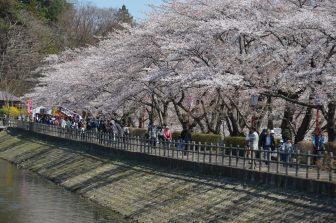Iwate, the second largest prefecture in Japan
Region: Tohoku
Capital: Morioka
Population: 1,258,113
Surface area covered: 15,075.01 square kilometres
The second largest prefecture after Hokkaido, Iwate is in the northern part of Japan in the Tohoku region.
Iwate is bordered to the north by the prefecture of Aomori, to the west by the prefecture of Akita, to the east by the Pacific Ocean and to the south by the prefecture of Miyagi.
The population density of Iwate is the lowest in Japan after Hokkaido.
Iwate has many mountainous areas with the highest of these being to the west along the border with the Akita prefecture which includes Mount Iwate (1,919 metres), a still active volcano and Mount Kurikoma (1,626 metres).
In the past, this region of Japan was known for its mineral production which included gold and iron.
The main river is the Kitakami and the large plain that this crosses on its travels towards the sea is where the main cities of Iwate are located and for centuries has provided richly fertile soil for agricultural purposes.
What to see in Iwate
Morioka, the capital, does not boast any notable tourist attractions but, it is a beautiful city with spectacular views of the mountains which surround it on three sides.
What is also famous in Morioka is Wanko Soba, a type of buckwheat noodle which is served in such a way that after the first bowl, the noodles just keep coming until you simply cannot eat any more.
At cherry blossom time, we would strongly recommend visiting the local park where you can see the ruins of an old castle that was demolished at the end of the nineteenth century.
Historically, the most important city in Iwate is Hiraizumi.
It is thought that Iwate was inhabited even before the 8th century by a population that was a mixture of the Emishi people, (probably the Ainu) and people of Yamato lineage.
In any event, since the Heian period, the region was put under the control of the imperial household and a branch of the Fujiwara dynasty, the same family who held power over the capital, Kyoto, and who settled in the north to govern the actual territories of Iwate and Fukushima which gave rise to the expression “the Fujiwara of the North.”
Hiraizumi was the centre of this power base and seemed to rival Kyoto when it came to the beauty and splendour of its temples and works of art.
The Fujiwara of the north were in power until the end of the Heian period and some vestiges of the splendours from their time in power can still be seen today such as the Chusonji Temple which was originally a vast complex of temples consisting of numerous buildings, only two of which still survive.
One of these is the Konjikido, a small building dedicated to the Amida Buddha which is completely covered in gold like the Kinkakuji of Kyoto but this one dates back to three centuries earlier and contains various Buddhist statues.
The Kojikido is listed as a national treasure.
Another temple dating back to the period of the “Fujiwara of the North,” is the Motsuji, which also belongs to the Tendai sect as per the temple referenced above.
What remains of this and is of notable interest is the garden which also dates back to the Heian period.
Then there is the Takkoku no iwaya which is just 6km from Hiraizumi and is a temple that has been built under an overhanging rock and is dedicated to the Bishamon-ten divinity.
From the point of view of nature, there are several places that merit a visit along the 200km of the Sanriku coast line which touches the three prefectures of Iwate, Aomori and Miyagi.
The coast line did suffer considerable damage from the tsunami of 2011. Tourism is seen as an important resource for the territory and for its restoration, if at all possible, to its previous state, prior to this significant natural disaster.
cherry blossoms
[ Apr.2017 ] On the last day of our family holiday in the north of Japan, we came back to Morioka City and went to see the cherry blossoms. In Kanto area where Tokyo is,…


